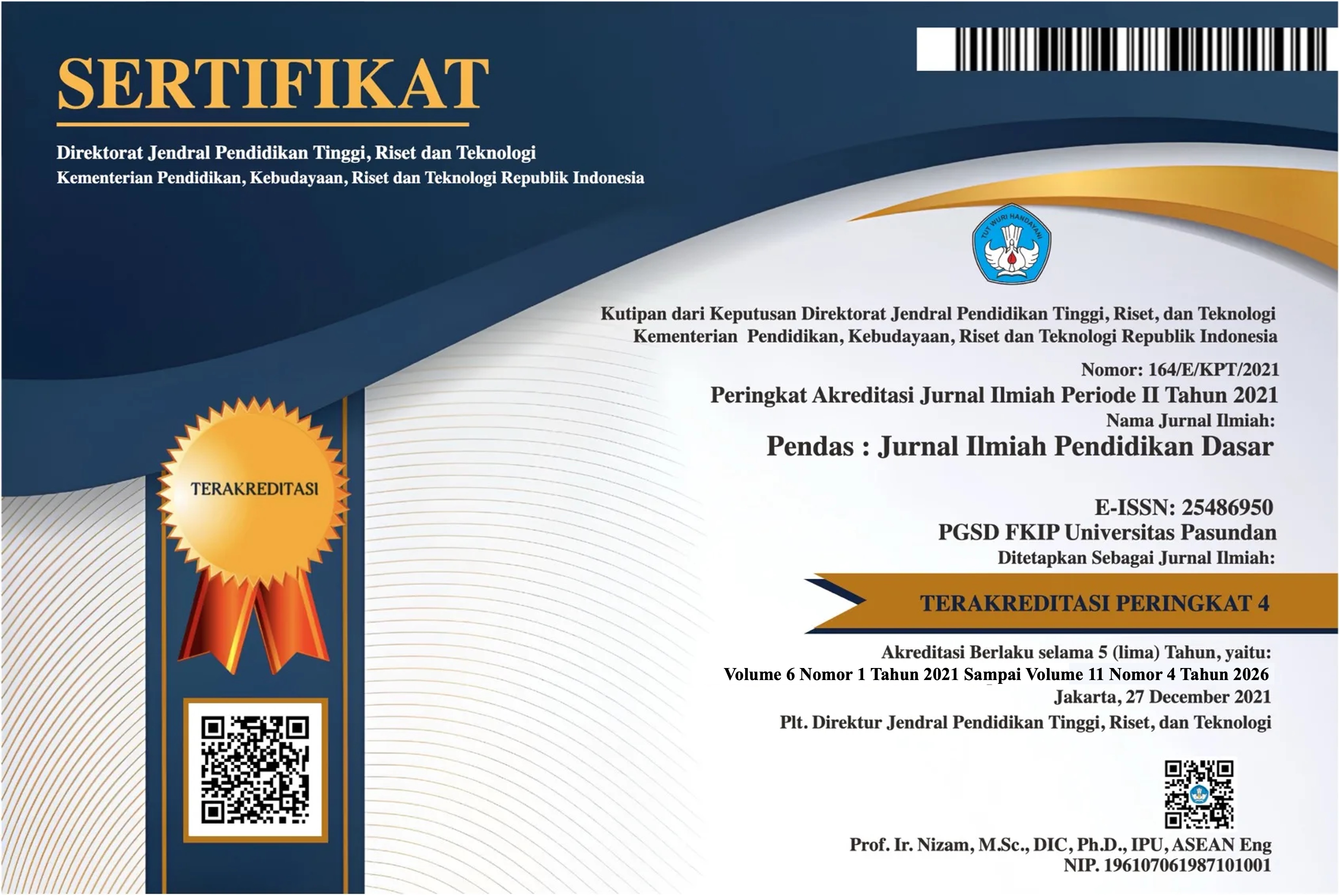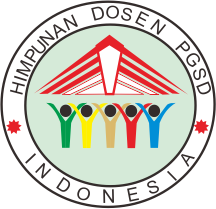ANALISIS EFEKTIVITAS PROGRAM SAHABAT POHON DALAM MEMBANGUN KARAKTER DAN SIKAP PEDULI LINGKUNGAN SISWA SEKOLAH DASAR
DOI:
https://doi.org/10.23969/jp.v9i03.16504Keywords:
sahabat pohon program, environmental awareness, elementary schoolAbstract
Increasingly complex environmental problems require an effective educational approach to build the character and attitude of environmental care from an early age. This study aims to evaluate the effectiveness of the Sahabat Pohon Program in building character and attitudes of environmental care in elementary school students, analyzing its impact, identifying factors that influence its effectiveness, as well as challenges and opportunities for its implementation. This research was conducted using descriptive qualitative method. Data collection was conducted using interview techniques, observation, and document analysis. The results showed that the Sahabat Pohon Program is effective enough in building character and environmental care attitudes, marked by an increase in ecological awareness, sense of responsibility, and pro-environmental behavior of students. Key success factors include direct experience with nature, curriculum integration, and community support. The main challenges include limited resources and curriculum integration, while the program opens up opportunities for the development of more comprehensive environmental education.
Downloads
References
Amini, R., & Munandar, A. (2010). Pengaruh Model Pembelajaran Pendidikan Lingkungan Berbasis Outdoor terhadap Penguasaan Konsep Pendidikan Lingkungan Bagi Calon Guru Sekolah Dasar. Jurnal Penelitian Pendidikan, 11(1), 14-21.
Ardoin, N. M., Bowers, A. W., & Gaillard, E. (2020). Environmental education outcomes for conservation: A systematic review. Biological Conservation, 241, 108224.
Bowen, G. A. (2009). Document analysis as a qualitative research method. Qualitative Research Journal, 9(2), 27-40.
Bronfenbrenner, U. (1979). The ecology of human development: Experiments by nature and design. Harvard University Press.
Chawla, L. (2020). Childhood nature connection and constructive hope: A review of research on connecting with nature and coping with environmental loss. People and Nature, 2(3), 619-642.
Creswell, J. W. (2013). Qualitative inquiry and research design: Choosing among five approaches (3rd ed.). Sage Publications.
Ghufron, A., Budiningsih, C. A., & Hidayati, H. (2017). Pengembangan pembelajaran berbasis nilai-nilai budaya yogyakarta di sekolah dasar. Cakrawala Pendidikan, 36(2), 309-319.
Hungerford, H. R., & Volk, T. L. (1990). Changing learner behavior through environmental education. The Journal of Environmental Education, 21(3), 8-21.
IPCC. (2022). Climate Change 2022: Impacts, Adaptation and Vulnerability. Contribution of Working Group II to the Sixth Assessment Report of the Intergovernmental Panel on Climate Change. Cambridge University Press.
Kementerian Lingkungan Hidup dan Kehutanan. (2018). Pedoman Pelaksanaan Program Adiwiyata. Jakarta: KLHK.
Kementerian Lingkungan Hidup dan Kehutanan. (2019). Pedoman Pelaksanaan Program Adiwiyata. Jakarta: KLHK.
Kementerian Pendidikan dan Kebudayaan. (2017). Konsep dan Pedoman Penguatan Pendidikan Karakter. Jakarta: Kemendikbud.
Kementerian Pendidikan dan Kebudayaan. (2019). Pedoman Pengembangan Muatan Lokal. Jakarta: Kemendikbud.
Kementerian Pendidikan Nasional. (2010). Pengembangan Pendidikan Budaya dan Karakter Bangsa: Pedoman Sekolah. Jakarta: Kemendiknas.
Keraf, A. S. (2014). Filsafat Lingkungan Hidup: Alam sebagai Sebuah Sistem Kehidupan. Yogyakarta: Kanisius.
Muharam, A. (2014). Model Pendidikan Lingkungan Hidup di Sekolah Dasar. Jurnal Penelitian Pendidikan, 14(1), 15-22.
Orr, D. W. (1992). Ecological literacy: Education and the transition to a postmodern world. SUNY Press.
Otto, S., & Pensini, P. (2017). Nature-based environmental education of children: Environmental knowledge and connectedness to nature, together, are related to ecological behaviour. Global Environmental Change, 47, 88-94.
Palmer, J. A. (2002). Environmental education in the 21st century: Theory, practice, progress and promise. Routledge.
Piaget, J., & Inhelder, B. (1969). The psychology of the child. Basic Books.
Pramudya, E. P., Supriatna, N., & Wilodati, W. (2019). Pengembangan Green School di Sekolah Dasar Kota Bandung. Jurnal Pendidikan Guru Sekolah Dasar, 4(2), 102-111.
Pratomo, S. (2008). Pendidikan Lingkungan. Bandung: Sonagar Press.
Rahmawati, F. P., & Suwanda, I. M. (2015). Penanaman karakter peduli lingkungan bagi siswa di SDN Pleburan 04 Semarang. Unnes Civic Education Journal, 1(2), 46-53.
Situmorang, R. P. (2016). Analisis Potensi Lokal untuk Mengembangkan Bahan Ajar Biologi di SMA Negeri 2 Wonosari. Jurnal Pendidikan Sains, 4(1), 51-57.
Stapp, W. B., Bennett, D., Bryan, W., Fulton, J., MacGregor, J., Nowak, P., Swan, J., Wall, R., & Havlick, S. (1969). The concept of environmental education. Journal of Environmental Education, 1(1), 30-31.
Stevenson, K. T., Peterson, M. N., Bondell, H. D., Mertig, A. G., & Moore, S. E. (2013). Environmental, institutional, and demographic predictors of environmental literacy among middle school children. PLoS ONE, 8(3), e59519.
Stevenson, R. B., Brody, M., Dillon, J., & Wals, A. E. (2014). International handbook of research on environmental education. Routledge.
Supriatna, N. (2018). Prosa dari Praha: Narasi Historis Masyarakat Konsumen Era Kapitalisme Global. Bandung: Rosda.
Tapilouw, M. C., Firman, H., Redjeki, S., & Chandra, D. T. (2018). The Importance of Training Needs Analysis for Environmental Education Teachers. Jurnal Pendidikan IPA Indonesia, 7(4), 485-492.
UNEP. (2021). Making Peace with Nature: A scientific blueprint to tackle the climate, biodiversity and pollution emergencies. Nairobi: UNEP.
UNESCO. (1978). Intergovernmental Conference on Environmental Education: Final Report. Tbilisi, USSR: UNESCO.
UNESCO. (2016). Global Education Monitoring Report. Education for people and planet: Creating sustainable futures for all. Paris: UNESCO.
UNESCO. (2018). Issues and trends in Education for Sustainable Development. Paris: UNESCO.
Zubaidah, S. (2016). Keterampilan abad ke-21: Keterampilan yang diajarkan melalui pembelajaran. Seminar Nasional Pendidikan dengan tema "Isu-isu Strategis Pembelajaran MIPA Abad, 21(10).
Stevenson, K. T., Peterson, M. N., Bondell, H. D., Mertig, A. G., & Moore, S. E. (2013). Environmental, institutional, and demographic predictors of environmental literacy among middle school children. PLoS ONE, 8(3), e59519.
Stevenson, R. B., Brody, M., Dillon, J., & Wals, A. E. (2014). International handbook of research on environmental education. Routledge.
Supriatna, N. (2018). Prosa dari Praha: Narasi Historis Masyarakat Konsumen Era Kapitalisme Global. Bandung: Rosda.
Tapilouw, M. C., Firman, H., Redjeki, S., & Chandra, D. T. (2018). The Importance of Training Needs Analysis for Environmental Education Teachers. Jurnal Pendidikan IPA Indonesia, 7(4), 485-492.
UNEP. (2021). Making Peace with Nature: A scientific blueprint to tackle the climate, biodiversity and pollution emergencies. Nairobi: UNEP.
UNESCO. (1978). Intergovernmental Conference on Environmental Education: Final Report. Tbilisi, USSR: UNESCO.
UNESCO. (2016). Global Education Monitoring Report. Education for people and planet: Creating sustainable futures for all. Paris: UNESCO.
UNESCO. (2018). Issues and trends in Education for Sustainable Development. Paris: UNESCO.
Zubaidah, S. (2016). Keterampilan abad ke-21: Keterampilan yang diajarkan melalui pembelajaran. Seminar Nasional Pendidikan dengan tema "Isu-isu Strategis Pembelajaran MIPA Abad, 21(10).
Downloads
Published
Issue
Section
License
Copyright (c) 2024 Pendas : Jurnal Ilmiah Pendidikan Dasar

This work is licensed under a Creative Commons Attribution 4.0 International License.


















